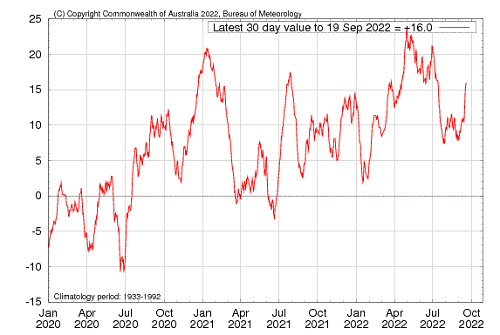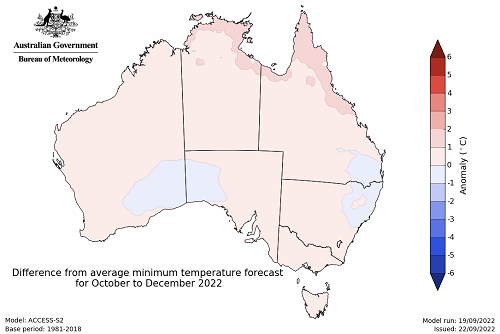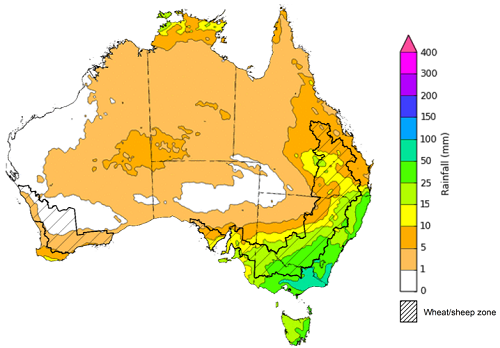Key issues
- For the week ending 22 September 2022, troughs, low-pressure and frontal systems brought showers and scattered storms to large areas of eastern and southern Australia. Weekly rainfall totals exceeding 50 millimetres were recorded in alpine areas of New South Wales and Victoria, as well as large areas of northern New South Wales, and Tasmania. Meanwhile, high-pressure systems over remaining parts of the country resulted in clear, dry conditions (see Section 1.1).
- The Australian Bureau of Meteorology recently announced that a third consecutive La Niña event has become established in the tropical Pacific Ocean. A negative Indian Ocean Dipole (IOD) event is also underway in the tropical Indian Ocean, and the Southern Annular Mode (SAM) is currently positive and expected to remain positive over the coming months. Given current and expected conditions, the La Niña event, the negative IOD event and the positive SAM are likely to be the major influences on spring rainfall across Australia and are associated with above average rainfall for southern and eastern Australia (see Section 1.2).
- The outlook for October to December 2022 suggests there is a greater than 65% chance of exceeding median rainfall across New South Wales, Victoria, most of Queensland, eastern and central parts of South Australia and the Northern Territory, as well as eastern Tasmania. The above average rainfall forecast across eastern cropping regions is likely to delay the harvest of winter crops as well as increase the risk of quality downgrades. Overly wet conditions are also expected to interfere with the planting of summer crops across northern cropping regions. Many growers who missed the opportunity to plant a winter crop due to wet conditions may face a similar problem with the planting of summer crops over the coming weeks and months (see Section 1.3).
- Over the 8-days to 30 September 2022, troughs, low-pressure and frontal systems are forecast to result in showers and scattered storms across south-eastern Australia. High-pressure systems will provide clear, dry conditions across remaining parts of the country. The moderate rainfall forecast across cropping regions in New South Wales and southern Queensland will increase risk of ongoing waterlogging across low-lying areas. Waterlogging and frost events remain the biggest potential downside risk to yields over the coming weeks. For the most part, above average soil moisture levels will support strong yield potentials, with crops flowering and grain filling during early spring (see Section 1.4).
- Water storage in the Murray–Darling Basin (MDB) increased by 245 gigalitres (GL) between 13 September 2022 and 20 September 2022. The current volume of water held in storage is 23,708 GL, which represents 94% of total capacity. This is 10% or 2,089 GL more than at the same time last year.
- Allocation prices in the Victorian Murray below the Barmah Choke decreased from $57 per ML on 9 September 2022 to $52 per ML on 15 September 2022. Prices are lower in regions above the Barmah Choke due to the binding of the Barmah Choke trade constraint.
Climate
For the week ending 22 September 2022, troughs, low-pressure and frontal systems brought showers and scattered storms to large areas of eastern and southern Australia. Weekly rainfall totals exceeding 50 millimetres were recorded in alpine areas of New South Wales and Victoria, as well as large areas of northern New South Wales, and Tasmania. Meanwhile, high-pressure systems over remaining parts of the country resulted in clear, dry conditions.
In Australian cropping regions, rainfall totals of between 10 and 50 millimetres were recorded across New South Wales, southern Queensland, Victoria, South Australia and isolated parts of Western Australia. Rainfall in excess of 50 millimetres was recorded across large areas of northern New South Wales. Little to no rainfall was recorded in remaining cropping regions of Western Australia for the week ending 22 September 2022.
Moderate to heavy rainfall across New South Wales and southern Queensland adds to already saturated soils in some regions, exacerbating waterlogging in low lying areas and negatively impacting winter crop development. These falls have also increased flood risk and the potential for flood damage to crops planted along riverine flood plains. A ‘Flood Watch’ is currently in place for New South Wales Northern Rivers, Mid North Coast and Hunter Districts.
In other cropping regions across south-eastern Australia, the recent rainfall will have boosted plant available moisture. As winter crops approach flowering and grain filling during spring, soil moisture levels will be critical to supporting yield potentials. Continued wet conditions across lager areas of eastern Australia have increased fungal disease risk for winter crops, which may negatively impact yield potentials if not managed. In Western Australia, rainfall in recent weeks has also boosted soil moisture levels heading into spring.
Rainfall for the week ending 22 September 2022
Note: The rainfall analyses and associated maps utilise data contained in the Bureau of Meteorology climate database, the Australian Data Archive for Meteorology (ADAM). The analyses are initially produced automatically from real-time data with limited quality control. They are intended to provide a general overview of rainfall across Australia as quickly as possible after the observations are received. For further information go to http://www.bom.gov.au/climate/rainfall/
Throughout Australia’s spring period the climate drivers with the largest potential impact on Australia’s climate patterns are the El Niño–Southern Oscillation (ENSO), the Indian Ocean Dipole (IOD), the Southern Annular Mode (SAM) and the Madden-Julian Oscillation (MJO). These climate drivers are likely to influence pasture growth across southern Australia, the growth and yield prospects for winter crops, as well as the planting of summer crops across northern cropping regions.
The Australian Bureau of Meteorology recently announced that a third consecutive La Niña event has become established in the tropical Pacific Ocean (see ABARES Weekly Australian Climate, Water and Agricultural Update 15 September 2022). Sea surface temperatures along the equator have been cooling over the past few months and recently reached La Niña thresholds. Trade winds have been stronger than average in the western Pacific and parts of the eastern Pacific. Cloudiness has also remained below average around the Date Line, which is consistent with the formation of a La Niña event. Three consecutive La Niña events are a rare phenomenon, having occurred only three times since 1900.
A negative IOD event is also underway in the tropical Indian Ocean, and the SAM is currently positive and expected to remain positive over the coming months. The MJO has remained weak since the start of September and expected to remain weak over the next 7-days. Given current and expected conditions, the La Niña event, the negative IOD event and the positive SAM are likely to be the major influences on spring rainfall across Australia.
Below average sea surface temperature (SSTs) anomalies in the tropical Pacific Ocean have strengthened over recent weeks, underpinning the development of the current La Niña event. A small pocket of weak warm anomalies remains in the eastern Pacific along the equator near South America. Meanwhile, warm SST anomalies have strengthened to Australia’s north and around the Maritime Continent in recent weeks.
Warm sea surface temperature anomalies continue across the eastern Indian Ocean to the north-west of Australia, while cool anomalies are present near the Horn of Africa and western parts of the Indian Ocean basin. The temperature gradient established across the tropical Indian Ocean underpins the ongoing negative IOD event.
Difference from average sea surface temperature observations 5 September to 11 September 2022
International climate model outlooks for the NINO 3.4 region in January 2023
The current La Niña event is forecast to peak in spring and dissipate in early 2023. Only three of the seven international models surveyed predict the La Niña event to persist into January 2023. For the period ending 19 September, the 30 day Southern Oscillation Index (SOI) value was 16.0 and the 90 day value for the period ending 11 September was 12.5, both of which are above the La Niña threshold of +7. La Niña events are associated with above average rainfall across eastern and northern Australia through spring and summer.
30-day Southern Oscillation Index (SOI) values ending 19 September 2022
A negative IOD event continues in the Indian Ocean, with values exceeding the negative IOD threshold (−0.4 °C) since mid-June. Warmer than average water temperatures in the east of the Indian Ocean and cooler than average temperatures in the west are associated with above average rainfall across southern Australia throughout winter and spring, as well as the far north. It is also associated with the early onset of northern Australia rainfall.
As at 11 September 2022, the Indian Ocean Dipole (IOD) weekly value was -0.79°C. All international climate models surveyed by the Bureau of Meteorology predict the negative IOD event to persist throughout spring, then rapidly decay in early summer.
Monthly sea surface temperature anomalies for IOD region
The Southern Annular Mode (SAM) has been predominantly positive over the past fortnight and is expected to remain positive over the coming weeks. The SAM refers to the north-south shift of the band of rain-bearing westerly winds and weather systems in the Southern Ocean compared to the usual position. A positive SAM in spring is associated with increased rainfall for parts of eastern New South Wales and Victoria as well as southern Queensland. It is also associated with decreased rainfall for parts of south-western and south-eastern Australia.
Southern Annular Mode (SAM) daily index
These climate outlooks are generated by ACCESS–S (Australian Community Climate Earth-System Simulator–Seasonal). ACCESS–S is the Bureau of Meteorology's dynamic (physics-based) weather and climate model used for monthly, seasonal and longer-lead climate outlooks.
For further information, go to http://www.bom.gov.au/climate/ahead/about/
The Bureau of Meteorology’s latest rainfall outlook indicates wetter than average conditions are expected across much of Australia during October. The ACCESS-S climate model suggests there is close to a 60% chance of exceeding median rainfall for parts of eastern, northern and central Australia, with below median rainfall likely for the south-west of Western Australia and western Tasmania.
Across cropping regions there is a 75% chance of rainfall totals of between 25 and 50 millimetres across eastern New South Wales, much of Queensland, and isolated parts of southern Victoria and South Australia during October. There is a 75% chance of rainfall less than 25 millimetres for remaining parts of New South Wales, Queensland, Victoria and South Australia, as well as cropping regions of Western Australia. These falls are likely to be sufficient to support the current yield potential of winter crops and average or better pasture growth potential, given average to above average soil moisture level across most southern Australian growing regions.
Rainfall totals that have a 75% chance of occurring October 2022
The rainfall outlook for October to December 2022 suggests there is a greater than 65% chance of exceeding median rainfall across New South Wales, Victoria, most of Queensland, eastern and central parts of South Australia and the Northern Territory, as well as eastern Tasmania. For remaining regions of Australia, there is no strong tendency towards above or below median rainfall, except for large areas of Western Australia where below median rainfall is likely between October and December 2022 (Bureau of Meteorology ‘National Climate Outlook’, 22 September 2022).
Bureau of Meteorology rainfall outlooks for October to December have greater than 55% past accuracy across most of Australia. Outlook accuracy is greater than 65% across most of New South Wales and Victoria, as well as parts of Queensland, South Australia and the Northern Territory. Past accuracy is low (less than 50%) for the south-west of Western Australia and parts of central Australia.
Chance of exceeding the median rainfall October to December 2022
The outlook for October to December 2022 suggests there is a 75% chance of rainfall totals between 50 and 200 millimetres across Victoria, most of New South Wales, Queensland and the Northern Territory, southern and north-western parts of South Australia, the south-west and far north of Western Australia and Tasmania. Rainfall totals in excess of 200 millimetres are forecast for alpine areas in New South Wales and Victoria, as well as parts of eastern New South Wales, Queensland and Victoria, the northern tropics and western Tasmania.
Across cropping regions, there is a 75% chance of receiving between 50 and 100 millimetres across south-western New South Wales, north-western Victoria, much of South Australia and south-eastern parts of Western Australia. Totals of between 100 and 200 millimetres are expected across much of New South Wales and Queensland, and eastern Victoria. Rainfall in excess of 200 millimetres is forecast for northern cropping regions of Queensland.
The above average rainfall forecast across eastern cropping regions is likely to delay the harvest of winter crops as well as increase the risk of quality downgrades. Parts of New South Wales and southern Queensland are already seeing crop damage due to flooding, with above average forecast rainfall over the coming weeks to exacerbate such issues. Wet conditions are also expected to interfere with the planting of summer crops across northern cropping regions.
Many growers who missed the opportunity to plant a winter crop due to wet conditions may face a similar problem with the planting of summer crops over the coming weeks and months. Conditions are looking very favourable across most southern and western cropping regions for this point in the season. Above average rainfall still presents a risk for the end of the winter cropping season. However, yield potentials are well above average and current soil moisture levels will support winter crops through critical flowering and grain filling stages over spring.
Rainfall totals that have a 75% chance of occurring October to December 2022
The temperature outlook for October to December 2022 indicates that maximum temperatures across most of Australia are likely to be close to the 1990-2012 average (the difference in the range of - 1°C to +1°C), with slightly lower than average maximum temperatures across eastern New South Wales and south-eastern Queensland. Minimum temperatures are expected to be slightly above average for parts of the northern Australia, and close to average for the rest of Australia (Bureau of Meteorology ‘National Climate Outlook’, 22 September 2022).
Predicted maximum temperature anomaly for October to December 2022
Predicted minimum temperature anomaly for October to December 2022
Over the 8-days to 30 September 2022, troughs, low-pressure and frontal systems are forecast to result in showers and scattered storms across south-eastern Australia. High-pressure systems will provide clear, dry conditions across remaining parts of the country.
In Australian cropping regions, rainfall totals of between 10 and 50 millimetres are expected across much of New South Wales, parts of southern Queensland, as well as most of Victoria and South Australia. Little to no rainfall is forecast for remaining cropping regions in north-western New South Wales, Queensland, western South Australia, and Western Australia during the next 8-days.
The moderate rainfall forecast across cropping regions in New South Wales and southern Queensland will increase risk of ongoing waterlogging across low-lying areas. These wet conditions are expected to prolong the inability to access fields for disease management and prolonged inundation may start to negatively impact yield potentials, presenting a potential downside risk to the current well above yield expectations in some growing regions.
Waterlogging and frost events remain the biggest potential downside risk to yields over the coming weeks. For the most part, above average soil moisture levels will support strong yield potentials, with crops flowering and grain filling during early spring. In Central Queensland, harvesting of winter crops and planting of long-season summer crops should get underway in the coming weeks. Central Queensland growers will be hoping for clear, dry conditions to facilitate timely planting and harvesting operations.
Total forecast rainfall (mm) for the period 23 September to 30 September 2022
Note: This rainfall forecast is produced from computer models. As the model outputs are not altered by weather forecasters, it is important to check local forecasts and warnings issued by the Bureau of Meteorology.
Water
Water storages, water markets and water allocations - current week
The Tableau dashboard may not meet accessibility requirements. For information about the contents of these dashboards contact ABARES.
Commodities
Information on weekly price changes in agricultural commodities is now available at the Weekly commodity price update.












